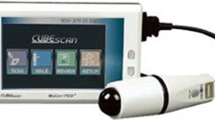Abstract
The most practical and accurate method to measure residual urine volumes in women is yet to be determined. The practicality of transvaginal ultrasound in measuring the range of residuals typically encountered in a group of 100 symptomatic women attending for urodynamic investigations was tested and compared with urethral catheterization. Transvaginal ultrasound was found to be more comfortable, less invasive and quicker. In ideal circumstances for both techniques, mean time from voiding until residual assessment was 47 seconds for transvaginal ultrasound and 270 seconds for urethral catheterization. Transvaginal ultrasound was applicable to 99% of women, with accurate assessment of residuals possible in 96% (100% for urethral catheterization). Eighty-five percent of women were found to have a residual under the level of likely clinical significance (30 ml). Transvaginal ultrasound permits the avoidance of catheterization in these women. Transvaginal ultrasound allows for immediate retesting of the residual, a feature not possible if there is bladder drainage by urethral catheterization. Of the 22 women with residuals initially over 30 ml, 11 (50%) were able to lower this by an average of 69%, 7 (32%) of these to under 30 ml, with an immediate further attempt at voiding. In terms of practicality, transvaginal ultrasound is the method of choice for residual determination in the vast majority of women attending for urodynamic investigations. While it is not possible to directly compare the accuracy of the two techniques, a theoretical comparison is possible by summation of their respective sources of error. This comparison showed that the two techniques, in ideal circumstances, have similar accuracies over the range 0–175 ml. In non-ideal circumstances, urethral catheterization has more potential sources of error.
Similar content being viewed by others
References
Hakenberg OW, Ryall RL, Langlois SL et al. The estimation of bladder volume by sonocystography. J Urol 1983;130:249–252
Mainprize TC, Drutz HP. Accuracy of total bladder volume and residual urine volume measurements: comparison between realtime ultrasonography and catheterization. Am J Obstet Gynecol 1989;160:1013–1016
Pedersen JF, Bartrum RJ, Grytter C. Residual urine determination by ultrasonic scanning. Am J Roentgenol 1975;125:474–478
Haylen BT. Residual urine volumes in a normal female population: application of transvaginal ultrasound. Br J Urol 1989;64:347–349
Baker KR, Drutz HP, Lemieux M-C. Limited accuracy of transvaginal probe ultrasound in measuring residual urine volumes. Int Urogynecol J 1993;4:138–140
Haylen BT, Frazer MI, Sutherst JR, Ashby D. Transvaginal ultrasound in the assessment of bladder volumes in women. Preliminary report. Br J Urol 1989;63:149–151
Haylen BT. Verification of the accuracy and range of transvaginal ultrasound in measuring bladder volumes in women. Br J Urol 1989;64:350–352
Haylen BT, Frazer MI, MacDonald JH. Assessing the effectiveness of different urinary catheters in emptying the bladder: an application of transvaginal ultrasound. Br J Urol 1989;64:353–356
Editorial Comment. Int Urogynecol J 1993;4:140
Haylen BT, Frazer MI, Sutherst JR, Ashby D. The accuracy of measurement of residual urine in women by urethral catheterization. Br J Urol 1989;63:152–154
O'Grady F, Cattell WR. Kinetics of urinary tract infections II. The bladder. Br J Urol 1966;38:156–162
Walter S, Vejlsgaard R. Diagnostic catheterization and bacteriuria in women with urinary incontinence. Br J Urol 1978;50:106–108
Stanton SL, Ozsoy D, Hilton P. Voiding difficulties in the female: prevalence, clinical and urodynamic review. Obstet Gynecol 1983;61:144–147
Bergman A, Bhatia NN. Uroflowmetry for predicting postoperative voiding difficulties in women with stress incontinence. Br J Obstet Gynaecol 1985;92:835–838
Lose G, Jorgensen L, Martensen SO et al. Voiding difficulties after colposuspension. Obstet Gynecol 1987;69:33–38
Author information
Authors and Affiliations
Rights and permissions
About this article
Cite this article
Haylen, B.T., Frazer, M.I. Measurement of residual urine volumes in women: Urethral catheterization or transvaginal ultrasound?. Int Urogynecol J 5, 269–272 (1994). https://doi.org/10.1007/BF00376238
Issue Date:
DOI: https://doi.org/10.1007/BF00376238




